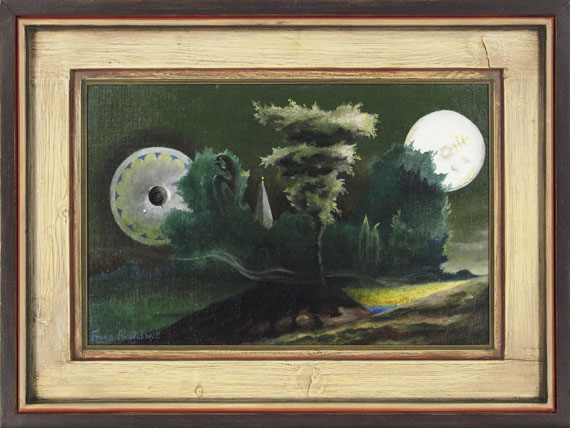385
Franz Radziwill
Wenn es in der Landschaft still ist, 1970.
Oil on canvas, mounted on panel
Estimate:
€ 12,000 / $ 14,160 Sold:
€ 45,000 / $ 53,100 (incl. surcharge)
Wenn es in der Landschaft still ist. 1970.
Oil on canvas, mounted on panel.
Firmenich / Schulze 837. Signed in lower left. Verso with the work number "633". 26.5 x 41.5 cm (10.4 x 16.3 in).
The work is registered in the artist's autographed work list 4 with the number 634. In the original artist frame.
• Mysterious reality.
• Typical Radziwill Surrealism which anticipates desaster in the idyl.
• In the original artist frame.
PROVENANCE: Galerie Bertram, Burgdorf (Switzerland).
Corporate collection Nordwest-Medien GmbH & Co. KG, Oldenburg (acquired from abovementioned gallery in 1992).
EXHIBITION: Franz Radziwill. Gemälde, Aquarelle, Handzeichnungen, traveling exhibition, Kunsthalle Bremen, December 13, 1970 to February 7, 1971.
Kunstverein Hanover, November - December 1971, Kunstamt Berlin-Wedding, Kunstamt Berlin Wilmerdorf, September 23 - October 29, 1971, no. 78.
Oil on canvas, mounted on panel.
Firmenich / Schulze 837. Signed in lower left. Verso with the work number "633". 26.5 x 41.5 cm (10.4 x 16.3 in).
The work is registered in the artist's autographed work list 4 with the number 634. In the original artist frame.
• Mysterious reality.
• Typical Radziwill Surrealism which anticipates desaster in the idyl.
• In the original artist frame.
PROVENANCE: Galerie Bertram, Burgdorf (Switzerland).
Corporate collection Nordwest-Medien GmbH & Co. KG, Oldenburg (acquired from abovementioned gallery in 1992).
EXHIBITION: Franz Radziwill. Gemälde, Aquarelle, Handzeichnungen, traveling exhibition, Kunsthalle Bremen, December 13, 1970 to February 7, 1971.
Kunstverein Hanover, November - December 1971, Kunstamt Berlin-Wedding, Kunstamt Berlin Wilmerdorf, September 23 - October 29, 1971, no. 78.
Franz Radziwill's pictures show a second reality, a world behind the world, portrayed witha painterly virtuosity and finesse that remained largely unmatched. Franz Radziwill createdfigurative works that leave a lot of room for interpretation while showing that realistic descriptions can also contain supernatural visionary elements. Our painting is one of the last works that Franz Radziwill, who suffered from glaucoma, completed; only two more numbers follow on the artist's list of works. [EH]
385
Franz Radziwill
Wenn es in der Landschaft still ist, 1970.
Oil on canvas, mounted on panel
Estimate:
€ 12,000 / $ 14,160 Sold:
€ 45,000 / $ 53,100 (incl. surcharge)
Headquarters
Joseph-Wild-Str. 18
81829 Munich
Phone: +49 89 55 244-0
Fax: +49 89 55 244-177
info@kettererkunst.de
Louisa von Saucken / Undine Schleifer
Holstenwall 5
20355 Hamburg
Phone: +49 40 37 49 61-0
Fax: +49 40 37 49 61-66
infohamburg@kettererkunst.de
Dr. Simone Wiechers / Nane Schlage
Fasanenstr. 70
10719 Berlin
Phone: +49 30 88 67 53-63
Fax: +49 30 88 67 56-43
infoberlin@kettererkunst.de
Cordula Lichtenberg
Gertrudenstraße 24-28
50667 Cologne
Phone: +49 221 510 908-15
infokoeln@kettererkunst.de
Hessen
Rhineland-Palatinate
Miriam Heß
Phone: +49 62 21 58 80-038
Fax: +49 62 21 58 80-595
infoheidelberg@kettererkunst.de
We will inform you in time.




 Lot 385
Lot 385 

